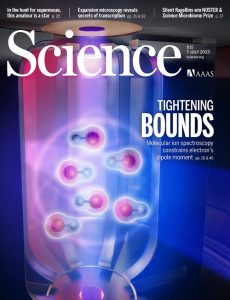
Science – Volume 380 Issue 6653, 07 July 2023
English | 148 pages | pdf | 72.36 MB
Museum ethics—more than lip service
In the past few years, museums around the world have started to grapple with questions about the origins and ethics of their collections. This in-cludes the acquisition and maintenance of natu-ral history specimens. As museums examine their missions and processes, it seemed like a good time to talk to Sean Decatur, the new president of the American Museum of Natural History (AMNH) in New York City. He spoke with me (see the full conversation here) about the museum’s research and how collabora-tions between museums and partner nations should aspire to assemble collections that
responsibly disseminate informa-tion about human cultures, the natural world, and the Universe.
Last December, Decatur tran-sitioned from university admin-istration (as president of Kenyon College in Ohio for 9 years) to mu-seum leadership. He makes a strong case that natural history collections are critical for science. The AMNH’s roughly 34 million specimens and objects, especially the biological collection, “tells the story of life on the planet,” he said. “You can really follow changes that have happened in species that might have been collected from the same geogra-phy over the course of more than a century now.” But Decatur is sensitive to how museums must responsibly build and keep such massive collec-tions. He acknowledged that standards have changed over time “not only in terms of agreements about own-ership of items being collected, but collaborations that involve the engagement of students and faculty from the partner nations and institutions where we’re col-lecting.” He boils it down to creating “a true two-way collaboration with students moving in both directions along the development of a project.”
Determining the proper home for objects from Indig-enous groups in the United States is governed by the Native American Graves Protection and Repatriation Act of 1990. I asked Decatur how the museum views compliance with these regulations when questions are raised about whether objects or specimens should be in New York. For items that belong to North American In-digenous groups, he emphasized that a clear process ex-ists for repatriation and that the museum has resources to work with Indigenous groups who claim ownership of objects that are in the museum’s collection. But he also wants to make sure that commitments are “more than lip service” by ensuring that the museum returns items that are not now, and were not in the past, col-lected under terms that do not meet today’s ethical standards. Moreover, Decatur is focused on building ful-some partnerships devoted to healing and moving for-ward from the past. “There’s more to returning items as a repatriation process than just putting them in the mail,” he said.
Earlier this year in May, the AMNH opened the Richard Gilder Center for Science, Education, and Innovation, which includes class-rooms and programs aimed at help-ing students—elementary grades through high school—understand that science is a process and not just a collection of facts. Decatur believes strongly in the ability of museum collections and exhibi-tions to provide a tangible connec-tion to textbooks. This relationship “can give confidence in what sci-ence has to tell us about the world,” he said. “You can’t really develop that confidence unless there’s an understanding of what the process is like. The museum offers a great opportunity for that, partially because there are objects that tend to capture excite-ment and wonder.” He admitted, “I still walk through the insectarium and look at the range of beetles that are in the collection and it just inspires a sense of wonder about the natural world.”
Museums must take on the important work of self-auditing and evaluating their conceptualization of what is collected and how, the stories their exhibits tell, the perspectives and processes involved, and the larger research and educational roles that they serve. Sean Decatur knows that these overhauls start with decision-makers like him.
–H. Holden Thorp
Download from: